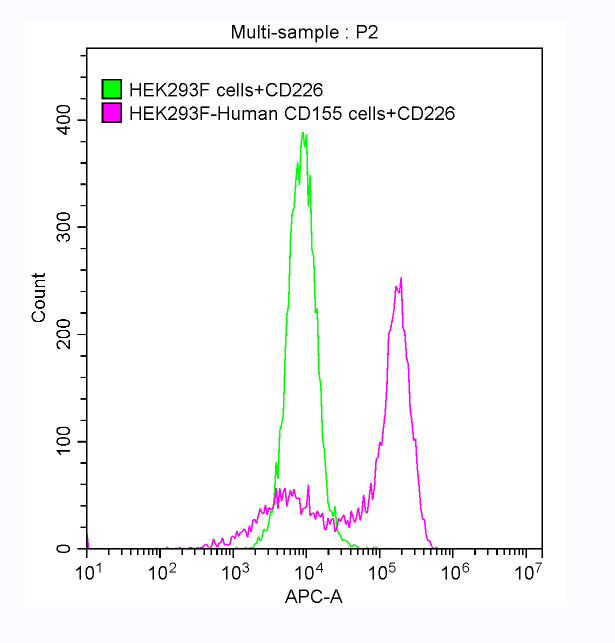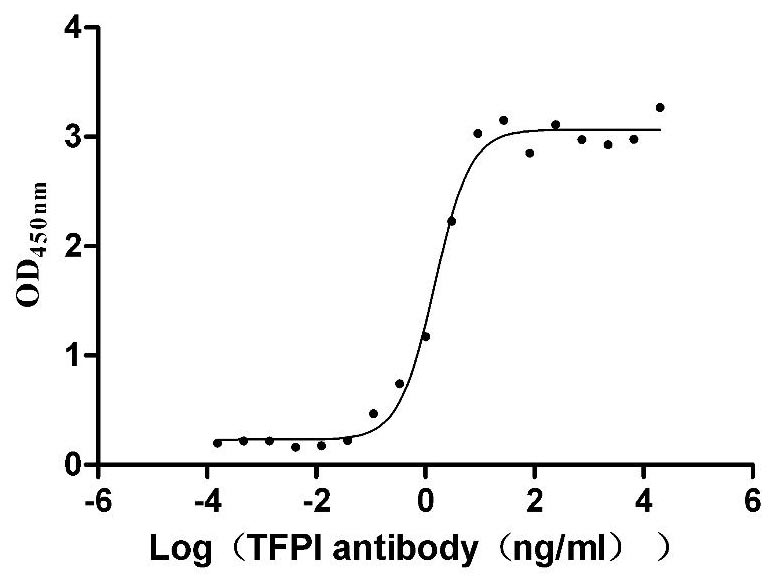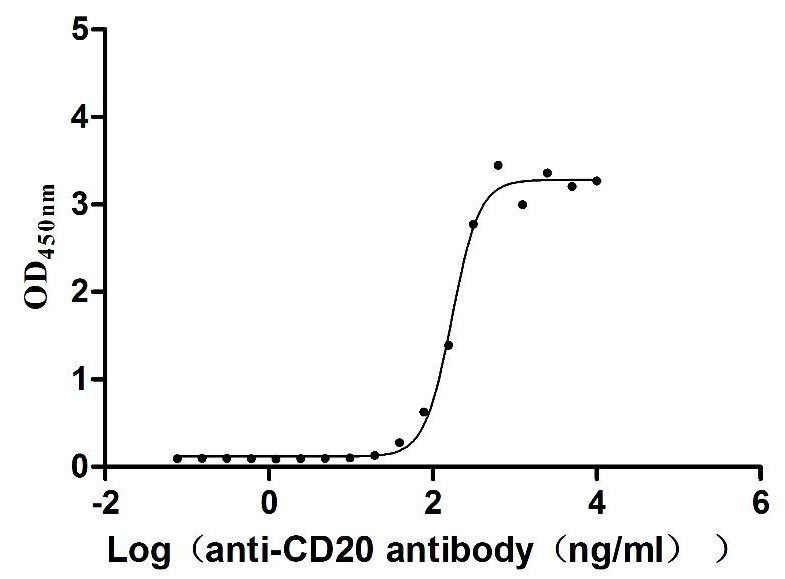Recombinant Human Tumor-associated calcium signal transducer 2 (TACSTD2)
-
货号:CSB-CF023072HU
-
规格:
-
来源:in vitro E.coli expression system
-
其他:
产品详情
-
基因名:
-
Uniprot No.:
-
别名:TACSTD2; GA733-1; M1S1; TROP2; Tumor-associated calcium signal transducer 2; Cell surface glycoprotein Trop-2; Membrane component chromosome 1 surface marker 1; Pancreatic carcinoma marker protein GA733-1
-
种属:Homo sapiens (Human)
-
蛋白长度:Full Length of Mature Protein
-
表达区域:27-323
-
氨基酸序列HTAAQDNCTCPTNKMTVCSPDGPGGRCQCRALGSGMAVDCSTLTSKCLLLKARMSAPKNARTLVRPSEHALVDNDGLYDPDCDPEGRFKARQCNQTSVCWCVNSVGVRRTDKGDLSLRCDELVRTHHILIDLRHRPTAGAFNHSDLDAELRRLFRERYRLHPKFVAAVHYEQPTIQIELRQNTSQKAAGDVDIGDAAYYFERDIKGESLFQGRGGLDLRVRGEPLQVERTLIYYLDEIPPKFSMKRLTAGLIAVIVVVVVALVAGMAVLVITNRRKSGKYKKVEIKELGELRKEPSL
Note: The complete sequence including tag sequence, target protein sequence and linker sequence could be provided upon request. -
蛋白标签:N-terminal 10xHis-tagged
-
产品提供形式:Liquid or Lyophilized powder
Note: We will preferentially ship the format that we have in stock, however, if you have any special requirement for the format, please remark your requirement when placing the order, we will prepare according to your demand. -
缓冲液:Lyophilized from Tris/PBS-based buffer, 6% Trehalose, pH 8.0
-
储存条件:Store at -20°C/-80°C upon receipt, aliquoting is necessary for mutiple use. Avoid repeated freeze-thaw cycles.
-
保质期:The shelf life is related to many factors, storage state, buffer ingredients, storage temperature and the stability of the protein itself.
Generally, the shelf life of liquid form is 6 months at -20°C/-80°C. The shelf life of lyophilized form is 12 months at -20°C/-80°C. -
货期:Basically, we can dispatch the products out in 1-3 working days after receiving your orders. Delivery time may differ from different purchasing way or location, please kindly consult your local distributors for specific delivery time.Note: All of our proteins are default shipped with normal blue ice packs, if you request to ship with dry ice, please communicate with us in advance and extra fees will be charged.
-
注意事项:Repeated freezing and thawing is not recommended. Store working aliquots at 4°C for up to one week.
-
Datasheet & COA:Please contact us to get it.
相关产品
靶点详情
-
功能:May function as a growth factor receptor.
-
基因功能参考文献:
- The results suggest that TROP2 expression could be an effective prognostic biomarker for oral squamous cell carcinoma PMID: 30098828
- TROP-2, SLP-2 and CD56 were effective diagnostic markers for PTC, especially when they were combined to use. PMID: 29951933
- Trop2 has a potential role in the promotion of EMT in BC. PMID: 29901160
- these results suggested that TROP2 may promote osteosarcoma cell proliferation and migration via PI3K/AKT signaling and may serve as a novel treatment target for osteosarcoma . PMID: 29845216
- TACSTD2 downregulation is associated with hepatocellular carcinoma. PMID: 29538454
- findings demonstrate that a membranous TROP-2 staining pattern is highly specific for PTC, which may serve as a potential diagnostic marker aiding in the accurate classification of morphologically equivocal thyroid follicular-patterned lesions PMID: 26862947
- TROP2 promoted the proliferation, migration and metastasis of gallbladder cancer cells by regulating PI3K/AKT pathway and inducing EMT. PMID: 28423362
- The results from clinical specimens showed that Trop2 expression correlated with MMP2 expression in primary thyroid cancer. The current study suggests that elevated expression of Trop2 may represent an important molecular hallmark that is biologically and clinically relevant to the progression of thyroid cancer. PMID: 28709407
- these results suggest a differential role for TROP2 in different lung cancer subtypes PMID: 28404926
- Results show that TROP2 expression is up-regulated in gastric tumor and its co-expression with AREG protein is associated with TNM stage, tumor size, lymph node metastases, and distant metastases. PMID: 28256068
- Our findings indicate that the expression of Trop-2 is a stringent predictor of tumor response to AKT inhibitors. They also support the identification of target-activatory pathways, as efficient predictors of response in precision cancer therapy. PMID: 27022065
- Findings suggest that high TROP2 expression identifies distinct cell sub-populations in androgen-sensitive and androgen-independent prostate tumors and that it may be a predictive biomarker for prostate cancer treatment response in androgen-sensitive tumors. PMID: 27283984
- TROP2 may play a crucial role in COPD by affecting basal cells function and thus airway remodeling through increased basal cells hyperplasia PMID: 27887617
- TROP2 was overexpressed specifically in the majority of epithelial ovarian cancer and may be a novel prognostic biomarker PMID: 27127000
- we compared the diagnostic value of TROP-2 expression in distinguishing between benign and malignant thyroid lesions to those of HBME-1, CK19 and galectin-3 PMID: 28547974
- TROP-2 membranous staining is a very sensitive and specific marker for the classic and tall cell variants of papillary thyroid carcinoma, and for papillary microcarcinomas , with high overall specificity for papillary thyroid carcinoma PMID: 27311870
- The results suggested that trop2 facilitated neovascularization of non-small-cell lung cancer via activating ERK1/2 signaling pathway. PMID: 28345466
- We identified a homozygous TACSTD2 missense mutation, c.551A>G, p.(Tyr184Cys), in the affected family members. Both parents were heterozygous for the mutation, and unaffected siblings were either heterozygous or homozygous wild-type for this allele. PMID: 27227392
- Our results expand the mutational spectrum of TACSTD2 in patients with gelatinous drop-like corneal dystrophy (GDLD). PMID: 27149532
- Trop2 expression was higher in GC tissues than in neighboring non-tumor tissues. Increased Trop2 protein levels in GC were associated with increased differentiation, tumor node metastasis stage, tumor size, lymph node metastasis, distant metastasis, and H. pylori infection. PMID: 26716416
- Trop-2 is a novel target for ADC therapy because of its high expression by many solid cancers. PMID: 26101915
- TROP2 is epigenetically down-regulated and operates as a negative regulator of cell proliferation and migration in liver fluke-associated cholangiocarcinoma. PMID: 26626643
- TROP-2 is specifically expressed in papillary thyroid carcinoma. PMID: 26481593
- overexpression of TROP2 appears to be an independent predictor for poor clinical outcome in nasopharyngeal carcinoma PMID: 26617817
- Lower GA733-2 expression in cancer tissues appeared to correlate with lymph node metastases (P < 0.05). GA733-1 gene expression was significantly higher in cancerous samples PMID: 26600538
- TROP-2 can be used as well as HBME-1 in thyroid cytology to detect PTC. PMID: 25164548
- Altogether, our data suggest that TROP2 plays an important role in promoting ADC and may represent a novel prognostic biomarker and therapeutic target for the disease. PMID: 26773504
- TROP2 protein is expressed at high levels in the colon cancer tissues. PMID: 26059528
- TACSTD2 protein, human is predicting lymph node metastases in OSCC, overall survival and disease-free survival. PMID: 24764155
- The amino acid exchange resulting from 4461T[C does not appear to alter binding of HO-3, suggesting that treatment with catumaxomab can be offered to patients regardless of their TACSTD1-genotype. PMID: 26115884
- These observations suggest that Trop2 serves an oncogenic role in LSCC and has potential as a therapeutic target PMID: 25779928
- This study reveals that both EpCAM and Trop2 overexpression in pituitary adenomas correlate significantly with invasiveness and proliferation. Follow-up analysis shows that Trop2 is a predictive factor for recurrence/progression for PAs. PMID: 25550831
- Trop2 loss triggers sensitivity to anti-ErbB3 antibodies, which results in reduced proliferation and tumorigenic growth of Trop2 negative head and neck squamous cell cancer cells. PMID: 25238142
- studies have begun to identify the mechanisms underlying TROP2's functions, including regulated intramembrane proteolysis or specific interactions with integrin b1 and claudin proteins. PMID: 25523132
- we demonstrate that the Trop-2 activation states are critical determinants of tumor progression and are powerful indicators of breast cancer patients survival. PMID: 24824621
- Inhibition of Tacstd2 expression significantly inhibited chemotherapeutic reagent-induced apoptosis, and TACSTD2 regulated apoptotic gene expression through P63 containing the transactivation domain (TAp63). PMID: 24651436
- Trop2 is important in proliferation and apoptosis regulation in CaSki cells, which may become a novel target for cervical cancer treatment. PMID: 24816726
- Overexpression of TROP2 predicts poor prognosis of patients with cervical cancer and promotes the proliferation and invasion of cervical cancer cells by regulating ERK signaling pathway. PMID: 24086649
- miR-125b-1 causes mitogen-activated protein kinase pathway dysfunction through regulation of TACSTD2 expression. PMID: 23416980
- The results of this study suggested that the TROP2 correlated with malignancy, proliferation and angiogenesis in human gliomas PMID: 23397225
- TROP2 gene expression can be used as an independent prognostic indicator for squamous cell carcinoma of the larynx. PMID: 22987366
- Used the Sf9 cells to express the Trop2 ectodomain (Trop2EC) in two forms - wt glycosylated (gTrop2EC) and mutant non-glycosylated form (Trop2EC(Delta/N)). Recombinant protein was purified and structure studied. PMID: 23872121
- Trop2 expression reflects a more malignant phenotype and may serve as an unfavorable prognostic factor for extranodal NK/T cell lymphoma, nasal type PMID: 23979406
- The cells exhibited a low epithelial barrier function as well as decreased expression of tight-junction-related proteins claudin 1 and 7. PMID: 23868985
- show that Trop-2 enhances directional prostate cancer cell migration, through modulation of Rac1 GTPase activity PMID: 23536555
- Network hubs and interacting partners are co-expressed with Trop-2 in primary human tumours, supporting a role of this signalling network in cancer growth. PMID: 22562244
- study characterized the expression of TACSTD2 in invasive ductal breast cancer(IDC) and adjacent non-malignant tissues; studies demonstrated that the high expression of TACSTD2 correlates with a poor prognosis in IDC PMID: 23031786
- Our data support a model where above-baseline expression of wild-type Trop-2 is a key driver of human cancer growth. PMID: 22349828
- High expression of TROP2 was associated with stage stage IIb colon cancer. PMID: 23055188
- More than 90% of Gelatinous drop-like corneal dystrophy (GDLD) patients possessed the same haplotype with a Q118X mutation in TACSTD2. PMID: 23038033
显示更多
收起更多
-
相关疾病:Corneal dystrophy, gelatinous drop-like (GDLD)
-
亚细胞定位:Membrane; Single-pass type I membrane protein.
-
蛋白家族:EPCAM family
-
组织特异性:Placenta, pancreatic carcinoma cell lines.
-
数据库链接:
HGNC: 11530
OMIM: 137290
KEGG: hsa:4070
STRING: 9606.ENSP00000360269
UniGene: Hs.23582
Most popular with customers
-
Recombinant Human CD226 antigen (CD226), partial (Active)
Express system: Mammalian cell
Species: Homo sapiens (Human)
-
Recombinant Human Tissue factor pathway inhibitor (TFPI), partial (Active)
Express system: Mammalian cell
Species: Homo sapiens (Human)
-
Recombinant Dog Angiopoietin-2 (ANGPT2) (Active)
Express system: Mammalian cell
Species: Canis lupus familiaris (Dog) (Canis familiaris)
-
Recombinant Dog B-lymphocyte antigen CD20 (MS4A1)-VLPs (Active)
Express system: Mammalian cell
Species: Canis lupus familiaris (Dog) (Canis familiaris)
-
Recombinant Human Tumor-associated calcium signal transducer 2 (TACSTD2), partial (Active)
Express system: Mammalian cell
Species: Homo sapiens (Human)
-
Recombinant Human C-type lectin domain family 4 member C (CLEC4C), partial (Active)
Express system: Mammalian cell
Species: Homo sapiens (Human)
-
Recombinant Human Cadherin-17 (CDH17), partial (Active)
Express system: Mammalian cell
Species: Homo sapiens (Human)
-
Recombinant Human Carcinoembryonic antigen-related cell adhesion molecule 8(CEACAM8) (Active)
Express system: Mammalian cell
Species: Homo sapiens (Human)




















